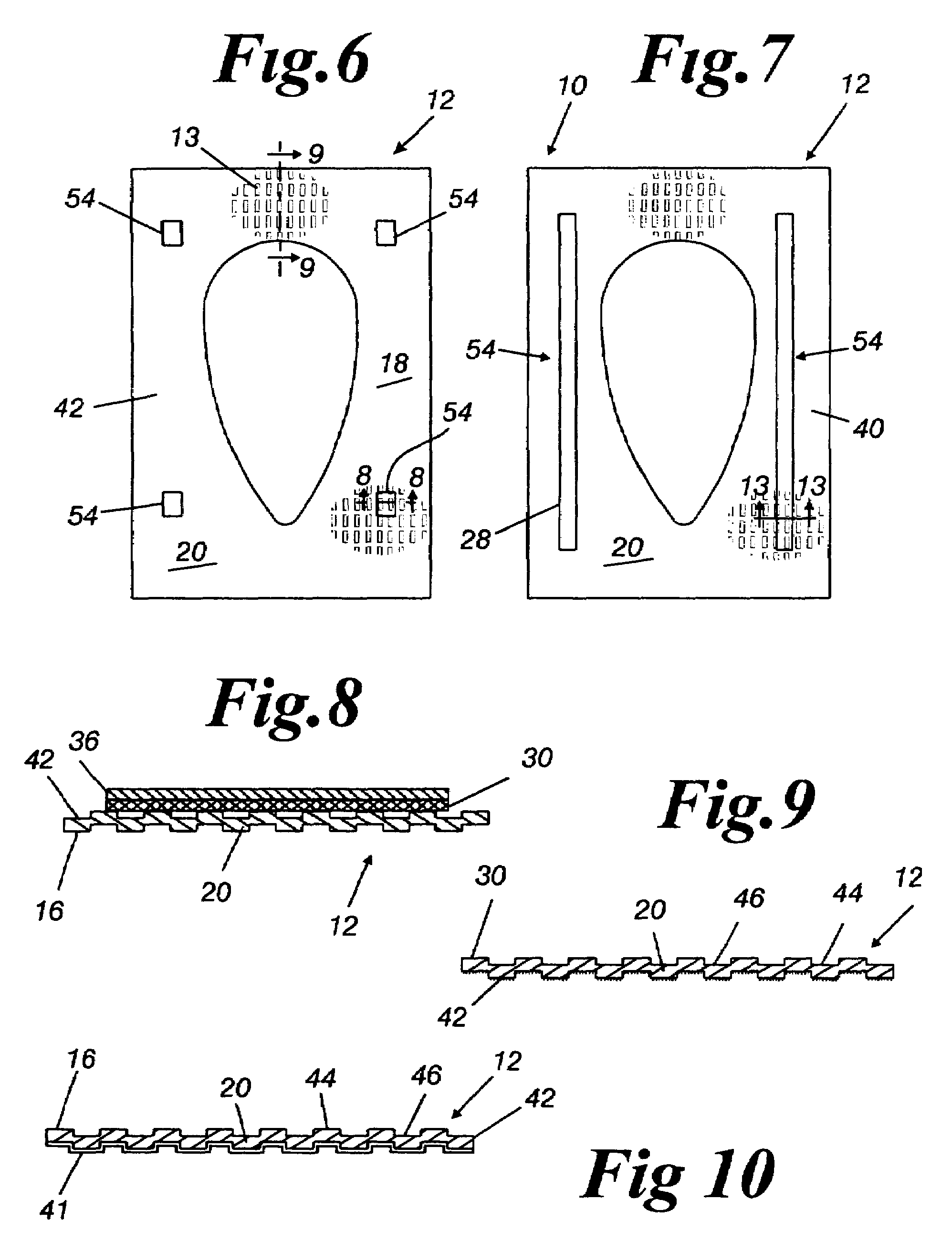[0013]The invention is an easy to fold sanitary toilet seat cover for preventing direct contact between an individual's
skin and the top and the side surfaces of a toilet seat. When unfolded, the toilet seat cover is sufficiently large to not only cover the entire elongated toilet seat, but also cover the sides of the seat. The disposable toilet seat cover comprises an annulus that is comprised of a quilted multilayer sheet having a water impervious layer and an absorbent layer, a wipe that is a detachable inner oval section that provides an opening to the toilet, and an adhesive fastening means for temporarily securing the annulus to a toilet seat. The water impervious layer comprises a coated layer and / or a filmic layer. The wipe detaches from an inner ovalled edge of the annulus, and is functional as a sanitary wipe or towel. The quilted multilayer sheet is conformable and soft enough to be used as a wipe. The water impervious coated layer or filmic layer on the wipe acts as a
protective barrier against the intrusion of water and
bacteria, thereby preventing the user's hands from becoming soiled during use. The apex of the wipe is shaped so as to be suitable for initiating and propagating the detachment of the inner oval section, and the apex is easier to start than a comparable circular or elliptical inner section. The disposable toilet seat cover is normally packed as a rectangularly folded sheet, which if needed can easily be refolded. The annulus preferably has a polygonal perimeter, where the preferred polygon is a rectangle having a length that is approximately the length of an elongated toilet seat, and a width that is slightly wider than the width of a toilet seat. The rectangular shape enables the disposable toilet seat cover to be easily folded.
[0014]The adhesive fastening means is preferably covered with a
release liner, which can be easily removed. The adhesive fastening means is preferably a
pressure sensitive adhesive or double coated adhesive on a carrier that is normally a film, where one of the two adhesives is a laminating adhesive that attaches the carrier to the annulus, and the exposed adhesive is a
pressure sensitive adhesive. The adhesive is selected to have minimal adherence to a toilet seat surface to ensure stability of the product in use while easily releasing and not depositing or leaving a residue on that toilet seat surface. The carrier reinforces the filmic layer and enables the use of a relatively higher tack adhesive to hold the disposable toilet seat cover in position. Also, the disposable toilet seat cover can be removed without delaminating the multilayer sheet. As previously stated, the multilayered sheet is quilted. Quilting is essentially a process of heavy
embossing that produces a multilayered sheet having a waffled morphology. The waffled sheet has a three dimensional pattern, wherein portions of the pattern are raised and intervening portions are recessed. Quilting pre-bends the multilayer sheet, imparting softness and
pliability, making it more conformable and softer on the skin. Quilting increases the overall surface area, which enhances the absorbency. The quilting makes the multilayer sheet somewhat spongy and improves the
thermal insulation, so a to provide a measure of warm and comfort. A significant proportion of the surface is recessed and therefore out of contact range of the adhesive. The net effect is to impart release properties to the surface of the multilayer sheet, making the disposable toilet seat cover much less susceptible to becoming entangled or otherwise distorted due to incidental contact with the adhesive when it is exposed. Quilting also increases the z-dimension strength of the multilayer sheet making it much less susceptible to delaminating. Quilting alone can be sufficient to bond the filmic layer to the absorbent layer, analogous to a stapleless paper
fastener. The absorbent layer can be comprised of one or more plies of a porous paper, or absorbent products, for instance nonwovens and those used in
personal care absorbent products. Examples of the latter include
infant diapers, adult incontinent pads, and feminine care products.
Personal care absorbent products typically contain an absorbent core that includes
superabsorbent polymer particles distributed within a
fibrous matrix. Superabsorbents are water-swellable, generally water-insoluble absorbent materials having a high absorbent capacity for body fluids. The superabsorbent polymers (SAP's) in common use are mostly derived from
acrylic acid. Other absorbent polymers are
modified cellulose, modified lignocellulose, or modified
polysaccharide. The modified
polymer is a sulfated
polymer such as sulfated
cellulose, a sulfated lignocellulose, and a sulfated
polysaccharide.
[0018]The principal object of the present invention is to provide a disposable sanitary toilet seat cover that is suitable for use with children for preventing direct contact between an individual's skin and the top and the side surfaces of a toilet seat.
[0020]A further object of this invention is to provide a disposable sanitary toilet seat cover having improved absorbency on the top-side, a place for
residual moisture on the toilet seat to migrate, added thickness with improved
thermal insulation and
cushioning, and improved conformability, hand and drape.
 Login to View More
Login to View More 


